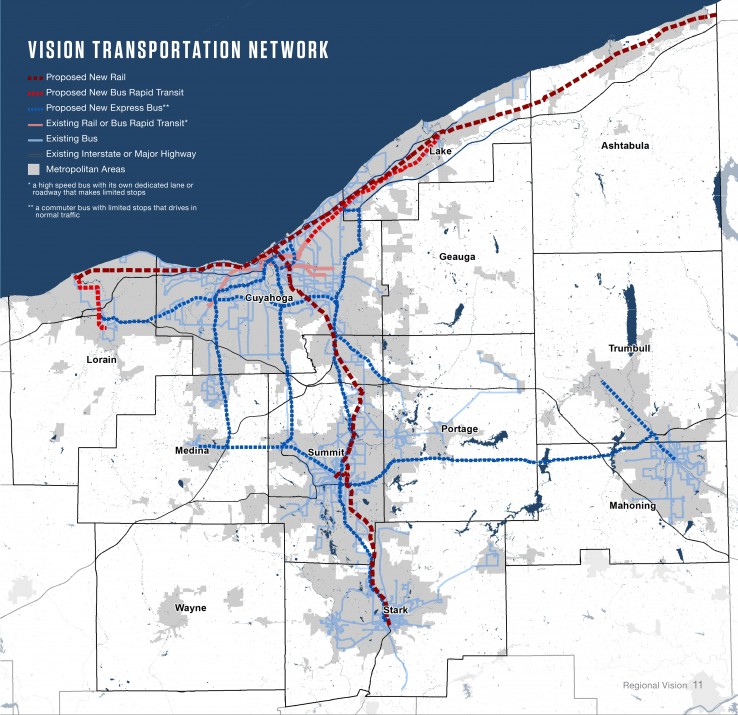On February 25, the NEOSCC Board will be voting on the the Vibrant NEO 2040 Vision, Framework and Action Products. Everyday over the next 5 weeks, we will be sharing an “Initiative A Day” so you can gain a better understanding of the vision and framework! If you would like to read all of the Initiatives, you can download them here Vibrant NEO Recommendation and Initiatives.
Show your support for Vibrant NEO 2040 by adding your name to our Champions of Vibrant NEO 2040 list here!
Initiative 5.3: Coordinate the region’s transit systems for joint marketing, information technology, and fare media, including information regarding private transit resources such as university/health system shuttles, private bus services, airport transportation, etc.
WHAT THIS MEANS: Transit users want the same ease of planning their travel as a motorist. Regardless of what operator is driving the bus and how many transfers are needed, riders should be able to plan their trips at one common website, pay with one common fare media, and track their trip on one mobile app. While transit ridership grows based on frequency, span, and location of service, transit ridership is kept through high quality of service. The infrastructure required to implement this initiative exists and requires only the common agreement to direct resources to implement it.
Information technology can contribute immensely to improving the experience of transit. The widespread deployment of computer aided dispatch (CAD) and automatic vehicle location (AVL) information infrastructure can be translated into a solution for resolving uncertainty associated with frequency and wait time. Many transit systems with high-capacity bus and rail service have implemented a “next bus” or “next train” information system that reads and broadcasts data from a CAD/AVL system onto station monitors. Greater Cleveland’s Regional Transit Authority implemented such an information system on the HealthLine BRT. In recent years, with the rise of mobile technology, some systems are implementing “real time arrival” information systems that broadcast vehicle location and estimated arrival times at stations and stop in a dynamic, real time environment. The rapid evolution of this technology, especially Google Transit, which operates on the General Transit Feed Specification (GTFS) information indexing system, promises to bring real time arrival technology within budgetary reach of smaller transit systems.
Fare technology has also advanced rapidly, making farecard deployment and inter-system fare integration much more technically and financially feasible. for medium-sized transit system. Washington, DC’s SmarTrip card, for instance, integrates farebox payment systems between the Washington Metropolitan Area Transit Authority and the Maryland Transit Authority, enabling seamless transfer between systems for riders.
Beyond technology-based enhancements to the customer experience, transit operators frequently coordinate operations with private transit operators such as university and health system shuttles, private paratransit services, and airport transportation. Public operators also occasionally engage in joint marketing campaigns to encourage ridership of transit in general. Joint marketing campaigns are frequent occurrences in Los Angeles and San Francisco, large metro regions with a decentralized transit operator network much like Northeast Ohio’s.
WHY THIS IS IMPORTANT: With financial resources for transit already scarce and growing scarcer, r transit operators must make savvy investments in improvements to “soft” infrastructure that can attract more customers to the service. Social media has created new opportunities for budget-friendly, cross-platform marketing and promotion of transit service, which, compounded with participation from multiple partners, can yield savings in marketing budgets that can be channeled to other uses. Investing in fare integration technology extends the spatial reach of transit systems, but arguably the highest-return investment is in real-time arrival information systems.
GETTING IT DONE: Transit operators should lead implementation of this initiative, evaluating their current information infrastructure, upgrading needs, and communications budget. MPOs can help to offset the cost of such investments through allocations of Congestion, Mitigation, and Air Quality (CMAQ[1]) funds or flexing of Surface Transportation Program (STP) dollars to transit agencies. CMAQ funds have been used elsewhere in the country to support everything from summer air quality awareness campaigns promoting transit to implementation of fare integration technology.
Lead |
Transit Operators; Metropolitan Planning Organizations; Municipalities, Counties; Universities |
Target Community |
Strategic investment areas, asset risk areas, cost risk areas |
Implementation Complexity |
Moderate |
These recommendations, initiatives, and products, are not one-size-fits all and some aspects of the initiatives won’t be applicable everywhere in the 12-county region. The Vibrant NEO 2040 Vision, Framework and Products are intended inspire and guide decision-making at the Metropolitan Planning Organization (MPO), Council of Government, and local levels to ensure that land use, transportation, and environmental considerations are simultaneously addressed by their processes. Ultimately, the implementation of Vibrant NEO 2040 is up to Northeast Ohio’s communities and residents. But regardless of the applicability of each initiative to any particular part of the region, the goal for each community within the Vision is the same: stability, prosperity, and a high quality of life for all of its residents.

